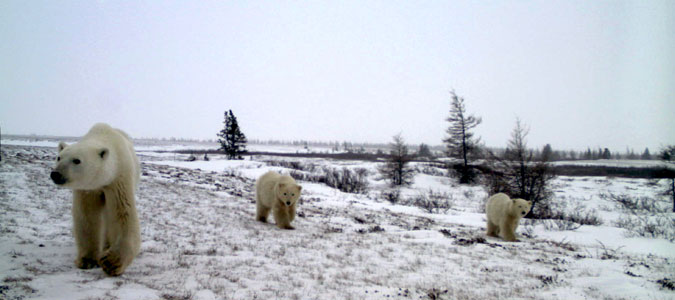Climate change, not hunting, the real threat to polar bears
A U.S.-backed proposal to severely limit or prohibit all cross-border trade in polar bears was voted down by the delegates to the Convention on International Trade in Endangered Species of Wild Fauna and Flora (CITES) on March 7, a development that relieved Douglas Clark.
By Michael Robin "From my perspective, this is very good news," said Clark, an expert on polar bear-human interaction and the U of S Centennial Chair in Human Dimensions of Environment and Sustainability.
"From my perspective, this is very good news," said Clark, an expert on polar bear-human interaction and the U of S Centennial Chair in Human Dimensions of Environment and Sustainability.While many animal welfare groups immediately expressed disappointment in the decision, Clark insists that further restricting international trade would do little to conserve the iconic animals and much to alienate northern peoples whose aid is desperately needed to help the species survive.
"Whatever you want to do with polar bears in the short term, you probably don't want to alienate Inuit if they're the ones who are more or less going to be in charge of the species' long-term future," said Clark, an assistant professor in the School of Environment and Sustainability.
In a paper in the March issue of the journal Marine Policy, Clark and his co-authors argued against a proposal to up list polar bears under CITES. Such a move would have effectively shut down sport hunts and sale of bear hides taken under subsistence quotas, crucial sources of income for many northern communities.
Clark's collaborators on the paper included representatives of two Inuit organizations and experts from the World Wildlife Fund (WWF), University of Alaska, Yale University and the University of Alberta. He explained that hunting is not endangering polar bear populations and in fact is carefully regulated. Territorial governments work closely with Inuit organizations, attempting to draw on biological and community knowledge to come up with sustainable quotas.
"Demand and price of hides does not play a factor in setting these quotas," Clark said. "That's what's being missed in all of the international promotion about up listing polar bears. Inuit really self regulate and adhere to these quotas very well."
Under the Canadian constitution and the legislation that created Nunavut, Inuit have control over much of the world's polar bear habitat, and two thirds of the world's polar bears. "They're at the table out of goodwill because they believe it's the right thing to do. Inuit hunters have the right to hunt as they see fit. Preserving goodwill and active Inuit involvement in these processes is absolutely critical."
Research in Nunavut has shown that on average, Inuit communities set aside only 22 per cent their quotas for sport hunters. There is no guarantee of success, and any unused hunting tags go back into the pool; in the Northwest Territories, those unused tags are cancelled. Clark explained that communities usually harvest their full quota of bears but sport hunters often do not, which means that allowing sport hunts actually reduces the numbers of bears killed each year. "That often really surprises people once they realize how the Canadian system works."
Clark and his collaborators assert that up listing polar bears under CITES allows governments to claim they are doing something to save polar bears by addressing peripheral threats while ignoring the big one—climate change and the habitat destruction it is causing. He said the bears need sea ice as a platform to hunt, and in 2012, that ice declined by a record 39 per cent.
"What I tell students now is if you're not scared, you're not paying attention, which is a bit of a harsh message, but people need to hear it. The world has not realized as a whole the magnitude of the changes that are going on up there."
Polar bears may survive, he said, but policies to help them should not distract from the impacts of climate change, and must include the knowledge and participation of the Inuit who know the North best.

